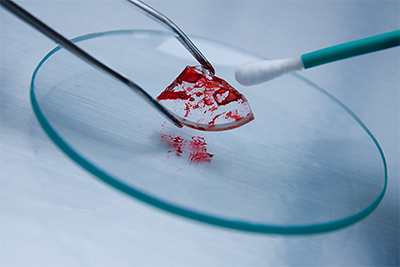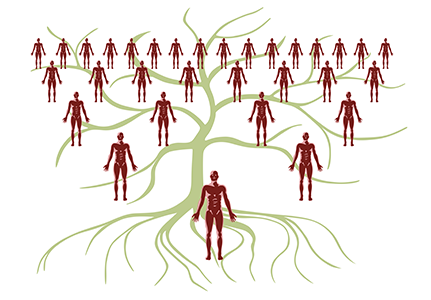Cells Teaming Up (2016 VERSION)
RETIRED BETA VERSION - For current versions of the SciGen materials, please visit serpmedia.org/scigen
IS IT REALLY YOU? THE ANSWER IS IN YOUR DNA!
The fact that all the cells of a multicellular organism have the same DNA is part of what makes that multicellular community an individual—a person, in the case of a human being. A person’s DNA is like his or her cellular ID card. You can take a DNA sample from any part of a person, and you’ve got something that identifies that person as a unique individual.
Here are some practical areas where the fact that each person has his or her own unique DNA makes a big difference:
Forensics
Forensic science applies scientific information and techniques to solving crimes. DNA evidence can be very useful in identifying murder victims, figuring out who was at a crime scene, and (just as importantly) proving the innocence of some suspects. A little saliva on the edge of a glass, a fallen hair, a bit of skin under the fingernail of an assault victim who fought an attacker, a drop of blood—tiny traces left by a human body can contain cells that carry DNA that says who they belong to.

Genealogy
Comparing the DNA of individual people can give us information about how closely related they are. This can clarify family relationships or, more broadly, reveal information about the migrations of early humans beginning in Africa and spreading around the world. Going beyond the human family, comparing the DNA of different species can give us information about how closely related different animals and plants are on an evolutionary scale.

Guarding Against Invasion
White blood cells working for the immune system can tell from checking the surface which cells have "self" DNA and which have “other” DNA. This is how a white blood cell can recognize that cells as different as your skin cells, muscle cells, liver cells, etc. all belong, but that a disease-causing bacteria is an invader that needs to be destroyed.
Watch this video clip. Can you spot the germs that this white blood cell is destroying?
MORE ABOUT DISEASEINFECTIOUS DISEASE (GERM-CAUSED DISEASES)The job of the immune system is to protect the body from infectious diseases, and also from cancer. Infectious diseases are diseases that spread from host to host. They are caused by germs (common term for pathogen: disease-causing viruses, bacteria, fungi, and parasites) that infect (get into) people. Bacteria, fungi, and parasites are all cellular organisms. Viruses are not; they are just little bits of DNA or RNA wrapped in protein, and are not generally considered to be alive. Viruses and some bacteria get right inside the cells of their hosts. Because viruses are not alive and don’t have any way of reproducing themselves by themselves, they hijack host cells, turning them into virus factories. (This process is a little like loading unwanted computer code into a computer and making the computer send copies of that code to other computers, which is why that kind of code is referred to as a computer virus; the code in that analogy is like a virus, and the computer is like a host cell.)DISEASES NOT CAUSED BY GERMSThere are also some diseases that are not caused by germs and are not infectious, like diabetes, heart diseases, stroke, osteoporosis, etc. Cancer is also different from germ-caused illnesses. Cancer happens when the body’s own cells have their DNA damaged in such a way that they start reproducing in an unhealthy, uncontrolled way. Cancer cells keep dividing and spreading, crowding out healthy body cells and consuming too many resources. A multicellular organism depends on cooperation and coordination between all of its member cells. In a sense, cancer cells have forgotten how to cooperate; they have become home-grown parasites, selfish and greedy, reproducing wildly and grabbing up space and resources to the point where they can damage or even kill the multicellular organism.
How do your cells help you fight disease and develop immunity?
THEY LEARN TO...
Recognize!
The immune system must distinguish between self and non-self. This includes being able to distinguish between healthy body cells and cancer cells. Even though cancer cells are descended from healthy body cells, the immune system needs to be able to recognize cancer as having become non-self. (To keep things simpler, though, we’ll focus mainly on germs this week.) And even though there are hundreds of kinds of cells in the human body (skin cells, muscle cells, epithelial cells, red and white blood cells, neurons, etc.), the immune system needs to be able to recognize that they are all in some important way the same: they are self. Recognition is basically done with various kinds of chemoreception, equivalent to our senses of taste and smell. White blood cells are constantly checking everything they come in contact with to see if they can detect molecules whose shapes identify things as self or non-self.
Remove!
The immune system has a variety of ways of fighting germs (and cancer cells). Some white blood cells (called phagocytes, “cell eaters”) basically eat germs. After engulfing germs, these white blood cells break them into tiny pieces, and they can show these pieces to other white blood cells in order to teach them what to hunt for. (“Teaching” is a huge, perhaps misleading simplification—it’s about clonal selection: the trick is to find the needle-in-a-haystack B cell and T cell that already know how to fight that antigen, activate them, and create the appropriate army of cloned B and T cells, with their flood of antigen-specific antibody, plus the memory B cells that will stand guard against subsequent reinfection.) Other white cells, like natural killer (NK) cells and killer T cells, destroy infected human cells in order to interrupt germ reproduction. Some white cells (B cells) also produce chemicals called antibodies that stick to the surfaces of germs. Antibodies help fight germs in more than one way: they mark the germs so that they become easier targets for other white cells to identify and attack; and antibodies can also interfere directly with the efficient functioning of germs.
Remember!
It takes a while for the immune system to figure out how to fight and remove new germs. While the immune system is getting together the right tools to fight an infection, the germs are multiplying a spreading and becoming a bigger and bigger problem. However, if the immune system can remember the germs it has fought in the past, it can respond more quickly when they show up again. So part of the job of the immune system is to keep a record of past infections and have tools ready to fight those old enemies. The ability of the immune system to recognize germs regardless of whether it has encountered them before is called innate immunity (innate refers to something that is there from the beginning and doesn’t have to be learned). The ability of the immune system to remember previously encountered germs and hit them extra hard and fast if they show up again is called adaptive immunity (because the immune system adapts—it learns and it makes special preparations to fight germs that it remembers).
The cells of the immune system need pieces of a specific kind of germ in order to adapt to and remember than specific kind of germ. But they really only need a piece, not the whole germ. So it’s possible to inject pieces of a germ (or whole dead germs) into a person and let that person’s immune system become an expert at fighting that germ without ever having the risk of infecting the person with live germs. That’s what vaccination is.
WHAT ABOUT VACCINES?
© SERP 2017
This Science Generation unit is currently in development. If you have comments or corrections, SERP would love to hear from you! Thank you.